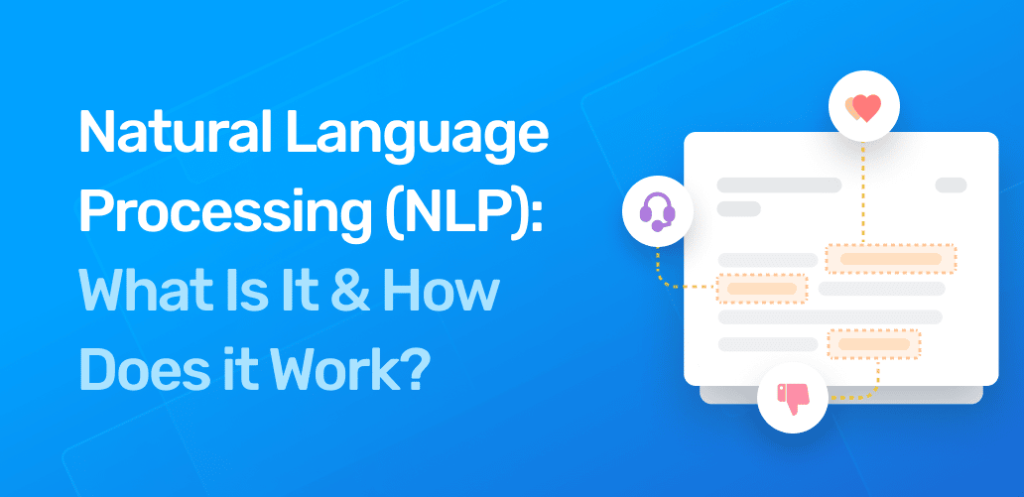How Natural Language Processing works is Explained

What is Natural Language Processing?
Natural language processing (NLP) is a component of artificial intelligence that supports computers to understand human language.
Natural language processing in layman’s terms means the technique which is used in AI and machine learning to help the system to understand and respond to the human language like a real human would do.
With a combination of computational linguistics and the field of computer science, this technology is brought into place.
This is achieved to close the gap between the processing of computers and human communication.
Use Cases of NLP
Think of the natural language processing in the google search engine, for example, you make a voice search by speaking to your phone and the related answers are provided.
You only experience some symptoms but when you type how you experience it, google can interpret your query and tell you the actual illness or disorder.
Think of the article spinners and Google Translate app that you use to translate articles from one language to the other.
What about chatbots in customer relations services? All these are examples and use cases of NLP.
Where did NLP start
The need for the communication gap to be filled between humans and computers has led this field to grow very fast.
This was possible with the support of big data and the available algorithms.
While humans communicate with the help of several languages, these languages cannot be interpreted by computers because the systems only understand machine language.
The processing happens with the crunching of the several zeros and ones in the system.
This, of course, leads to some possible errors.
The algorithms in place now help the systems to communicate in human form (in the case of digital assistants) where particular algorithms are even served for each user when there is a repetition in a given task.
There are voice-activated devices that will listen to the command given by the user and execute the command within seconds.
This is possible with the help of natural language processing which is combined with machine learning.
How does Natural Language Processing work?
Several techniques areused for interpreting human language.
This is done with the help of combining ML and algorithm techniques.
Since the applications of natural language processing seem to happen in varied fields, there is a need for a variety of approaches based on natural language processing.
Some basic tasks are handled with the help of natural language processing like speech recognition, language recognition, tokenization, etc.
The implication of natural language processing is seen primarily in the case of voice-activated virtual assistants.
Other than that this practice is used in the processing of emails, where a similar format in spam emails is analyzed and notified to the user.
In the case of mobile phones, there is a voice-based notification for missed calls which is possible with natural language processing.
It is also used in content categorization when a user tries to enter text in the search bar of a website.
In the case of Telecom, NLP can be used in billing customers.
All these are made possible by breaking down the language into smaller bits. Then these bits are analyzed and understood after which the tasks are processed.
Natural Language Processing Application
NLP can be used to search and arrange a given content based on the index for a language-based document.
This document can be sets of data present on a website too.
It will also notify in case there is any duplication of the data.
The meaning of the content can be interpreted by natural language processing to which the advanced analytical techniques can be added to even make a forecast of the data.
The basic extraction of the inputted data can be done in seconds with this technique.
There is also the possibility to do sentiment analysis with a specific set of data by combining it with opinion mining.
Commands from the user can be taken by the system and then it can be translated into the machine language after which the given command can be executed.
While the conversion of languages used by humans to machine languages is possible on one side, the translation between the several languages used by humans can also be done here.
There are Natural language processing use cases in the healthcare industry, where patients’ health education can be improved, individual patients’ needs are understood and the best approach to improving quality health care.
An example of use cases of NLP in banking and finance is in data analytics and customer relations where it is used to improve customer experience.
Complaints of individual clients in the bank can be analyzed to provide personalized service as much as possible.
Natural language processing is already transforming retail banking and the future trend holds much improvement.
The need for natural language processing
Since the data keeps on growing along with the complications of the several language diversities in humans, natural language processing is needed to convert these languages and then interpret them accordingly.
Since most of this data is unstructured, these systems are needed to analyze the huge set of data and process it efficiently.
While every language used by humans is different, there are still a lot of complications attached to these languages in terms of grammar and accents.
All it requires is a semantic understanding for analyzing and interpreting the data and providing a structure to it, especially in terms of speech recognition.
While there are several benefits of natural language processing, the main limitation here is the issue of quality and accuracy in machine translation.
However, this can be enhanced in the future and the pros outweigh the cons.





